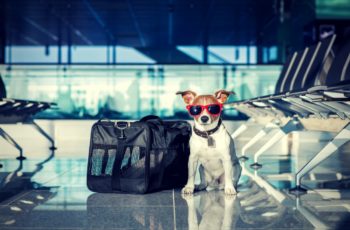
The American Humane Association estimates that 1 out of 3 pets become lost at some point in their lifetime and close to 10 million dogs and cats are lost or stolen in the US every single year and according to the Coalition for Reuniting Pets and Families, less than 23% of lost pets in the U.S. are reunited with their owners.
Pet tracking has proved to be an effective method for finding and reuniting lost pets with their owners. Joining us to discuss this approach is Carmen Brothers, a nationally recognized pet tracking expert and the founder of Found, an organization that brings home lost pets safe and sound. She was featured in National Geographic’s “Trackers” TV series. Carmen has spent the last decade working tirelessly to reunite pet owners with their lost pets. Her love of animals has taken her across the United States and into the hearts of countless families. We chatted with Carmen to learn more about her pet tracking and rescue efforts.
1) How did you get into involved in pet tracking?
Carmen started out as a volunteer for City Dogs Rescue in Washington, DC. There she got involved in finding a lost dog named Mattie. She worked on the logistics including putting up posters, flyers and learning about lost dog behavior. The rescue brought in a tracker to try to find Mattie. For Carmen this was a really great learning experience. She soon became City Dog’s lost pet coordinator. Anytime a cat or dog got lost, Carmen would start the process of finding the animal including everything from distributing the flyers to collecting a scent item to create an effective search.
2) What steps should someone who has lost their pet take once they know their pet has gone missing?
Create a clear and simple flyer (less is more in this case). This should include a big picture of the dog with the words lost and the phone number to contact a person if a sighting occurs. It is also important to state on the flyer that anyone spotting the animal should not chase them – that only makes it harder to find the pet. Don’t list your pet’s name on the flyer – that may just lead to people calling out for the lost animal and scaring the animal – making them stray even further. The flyers should be posted around a three to five mile radius from where the dog or cat was lost. This is important because a lost dog can travel anywhere from three to five miles a day. Lost animals typically follow a pattern for example they may circle around an area over a period of time, follow power lines or railroad tracks. However if they are chased that can alter this pattern and make it much more difficult to find them.
Another step is to reach out using social media – post your lost dog on the different websites that focus on lost pets. That includes Facebook, Helping Lost Pets, PetAmberAlert, and using robo calls through a site such as FindToto. Leverage your community and post to apps including Next Door and the Ring Door app, which can capture video of your pet while he or she is running around lost.
Leave something outside that your pet is attached to, so they can smell their owner’s scent. This can help draw the lost dog or cat back to their home. Since the animal uses their scent the most – this can be pretty effective.
3) Once a pet owner starts working with you to find their pet – what can they do to help you in the tracking process?
A key step is to find an item that has your pet’s scent on it. This is critical in helping the tracking dogs in establishing a scent they are going to go after and try to locate. Put the item in an unscented trash bag or zip lock bag to maintain the smell. In addition, a flyer will be created to support the tracking effort. Ideally contact a tracker within seven days of the animal going missing. The tracking effort includes looking at a map and determining areas to search. Look for water sources and train tracks that an animal may be following.
A key is making sure that everyone searching for the dog understands flight or survival mode – once an animal is lost its key to make sure that when you are searching for them that you don’t scare them with loud noises. So screaming their name, which might work for a human that is lost is actually detrimental for an animal – it has the potential to scare them even more when they are already in a frantic state. The Missing Animal Rescue Network explains this really well on their website. Use calming signals instead to have the lost animal come to you by attracting them with food.
4) How often are you able to locate a lost pet and how long does it usually take?
It all depends Carmen explains. Turtles for example don’t go very far, so they are easier to find. Dogs can travel three to five miles in a day, so that makes finding them much more challenging. Finding them depends on a lot of factors like the terrain, did they go missing because of an accident, are they a new foster or recently adopted dog so they don’t have strong attachments to the family. On average it could take anywhere from three to six weeks to find a lost dog. In one case Carmen worked on a rescue effort for a lost dog in West Virginia where the dog was lost for 179 days. There were sightings of the dog on a daily basis, but the pet would not go into a trap, so it made it very difficult to rescue her.

5) Are you able to track any kind of animal?
Yes…Carmen has even tracked a lost turtle. The key is having a scent item that her dogs can use to track. To track the turtle, a flower pot and a warming rock that the turtle enjoyed were used to generate a scent for the dogs. She has tracked cats, goats, horses, dogs and even a capiberra (in case’t you don’t know it’s the largest living rodent in the world that is native to South America). Carmen explains that if it moves and you have a scent item, then she and her dogs can come and find the animal.
6) How do you pets end up getting lost?
Carmen explains there are a whole host of situations that can lead to a pet escaping and getting lost. As an example, fourth of July, America’s independence day is one of the prime times when pets go missing. The fireworks that get blasted in celebration cause a lot of dogs to get very scared and run away. Holidays are another time when dogs often get loose. People are coming in and out of the house and doors are left open which creates an opportunity for a pet to wander out. New Year’s eve is also time when pets get lost – again because of the fireworks and loud noises. It can really happen to anyone, people tend to think it won’t happen to them, until it does. Carmen works with animal rescue organizations to help adopters and fosters to minimize the chance of a dog or cat getting lost.
7) What is the most challenging part about tracking a lost animal?
One of the key challenges Carmen explains is having everyone involved understand the tracking process itself. There are often common misunderstandings about the process from pet owners. Carmen explains pet owners often think that once the pet tracking effort starts their pet will be found that day. It has happened that a pet was found during the first day of the pet tracking effort, but it’s “less than five percent of the time”, explains Carmen. In the nine years that Carmen has been tracking it’s only happened about thirteen times. The pet will often be seen during the tracking effort, but the hard part is containing the pet. The tracking effort requires a strategy and process that takes time. Carmen works to find patterns where the pet is staying and moving around and uses cameras, feeding stations, and traps to try to capture the lost pet.
8) You have successfully reunited a lot of families with their dogs. Can you tell me about one of your favorite success stories?
About a year ago, Carmen tracked a sixteen year old dog in Northwest Washington, DC. She had been out tracking the dog for about seven to eight days and the tracking led her to Rock Creek Park – which is a very large territory to track a dog because there is a vast expanse of forested area. By chance they found the dog pretty quickly in the area. When that happened Carmen explained to the pet owner that she and her tracking dogs would leave, so they wouldn’t stress out the lost dog and cause the dog to wander even farther away.
Carmen told the pet owner to get on the ground, not to make eye contact with her pet, but just to let the dog get the owners scent so the dog would then come over to her owner. That is the best approach to not scare the dog, but to let the dog figure out that it is the owner, so they feel comfortable coming over. The lost animal’s current mindset is on survival, so they care constantly in fear and ready to run away. It took an hour and a half, but the dog did come over to the owner and the owner was able to put the dog on a leash and take the dog home that day.

9) How can someone with a lost pet take advantage of your services to find their beloved pet?
Carmen explains that if you have not had a sighting of your dog or cat in twenty-four to thirty six hours, then you should contact a pet tracker to help find your pet. If you have sightings of your pet, Carmen can help with the tracking effort by looking on a map to determine the best places to put feeding stations and traps, without her actually coming onsite. However, if you have no idea where your pet went and you have already taken the first steps in the rescue efforts like putting up flyers and posters, then it could be very helpful to contact Carmen to help find your pet.
10) What is the best way for someone with a lost pet to contact you?
The best way to reach Carmen is through her website – professionalpettrackers. You can also reach her through Facebook.
11) Is there any technology that can help minimize the chance of losing your pet?
One item that can help is a GPS collar, however, Carmen points out that if your dog isn’t wearing it at that time when they get lost then it is not very helpful. Today there is no GPS microchip that can be planted on a dog. Even if this was feasible there would be issues powering the chip, since it would require a charge to keep it active.
Carmen explains that it is the basic methods that prove to be successful in making sure your dog doesn’t stray. Having a leash to your dog’s harness and collar, getting to know your dog and being bonded before you take them to any kind of event that can prove stressful or letting them go off leash. It is critical to be super careful about taking care of your pet to make sure they don’t end up running away. As the old adage goes “It’s truly better to be safe than sorry”.


